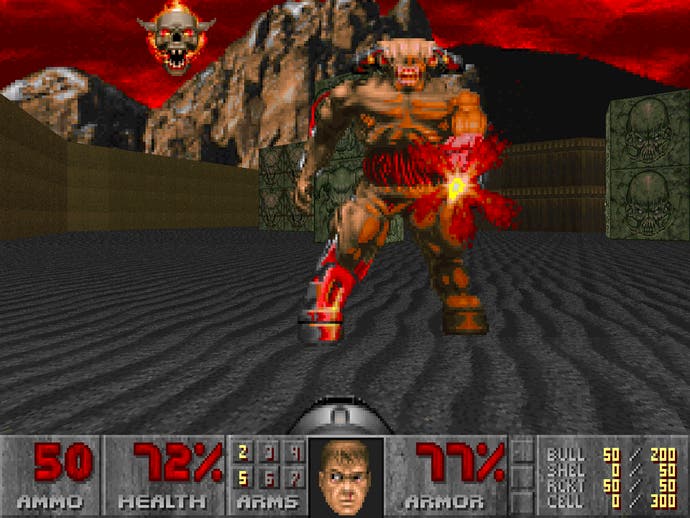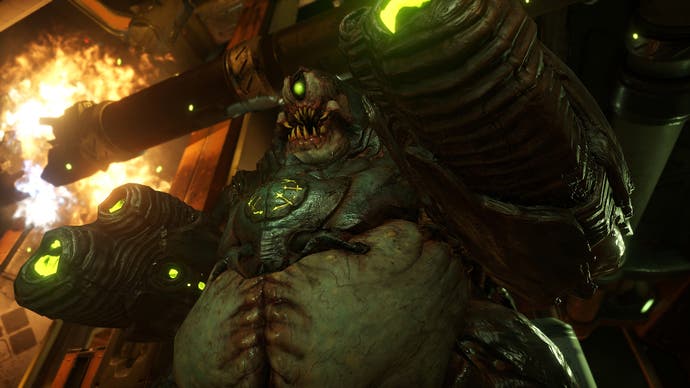22 years on, Doom retains the ability to shock
As does its reboot. Keith Stuart looks at the lasting appeal of id's formula
On the giant screen at the Dolby Theatre in Hollywood, home of the lavish Academy Awards ceremony, a demon is being sawn in half with a chainsaw. As torrents of blood and body parts spew toward the camera, the audience howls its approval. This is the pre-E3 press briefing by games publisher Bethesda, and what we're viewing is footage of the new Doom game.
Released in 1993 by Texan studio Id Software, the original Doom was a landmark in the first-person shooter genre, and one of the most debated and controversial games of all time. Putting players in control of a space marine sent to Mars to battle the incoming forces of Hell, the game introduced many to the first-person perspective, where players view the action as though through the eyes of the protagonist. This highly immersive effect, combined with the relentless bloody gore, set a new paradigm for the depiction of violence in video games. Doom seemed to combine all the fears of the religious right: loaded with guns and demonic imagery, accompanied by an electronic approximation of heavy metal music, and utterly nihilistic in its outlook, the shooter became a totem of generational dread. No wonder teenagers loved it.
Now, of course, Doom should seem sort of quaint. Its pixellated visuals, scratchy sound samples and limited three-dimensional environments are ancient artefacts beside the alarming visual realism of games like Battlefield and Call of Duty. But no. Doom remains an arresting and effective game, not only because its blocky aesthetic and anarchic humour resonate with nineties nostalgia, but because it somehow retains its disquieting power.
The shock of the old
The first shock about Doom has nothing to do with blood. The first shock is that it's still fascinating and challenging to play. Going back to the original, or at least a version running on the Xbox 360, it feels slick and frenzied, with its relentless barrage of swarming foes, that complex, multi-path level design (far more challenging than the conveyor belt-like structures of modern blasters), and its extraordinary sense of pace. It is incredibly pure.
No wonder then that, Id Software, after the rather bloated and disappointing Doom 3, has chosen to go right back to the beginning with its new instalment. "It's quintessential Doom," says executive producer Marty Stratton speaking to the Guardian on the showfloor at the E3 Expo. "I don't know if that means it's a reboot. You look out there and see how active the community is - there are still people playing it and making mods. Doom has this kind of timeless quality - the action works really well in the modern space."
What we're getting then is a retread of the original story - if you can call it a story. A portal to Hell has opened up above a colonial base on Mars and you're the marine sent up to kill all the demons. All the familiar weapons, from the shotgun to the chainsaw are back, as are the original gameplay mechanics. The likes of Halo, Gears of War and Call of Duty introduced dozens of innovations to smooth out the process of endlessly shooting at enemies, but this new Doom rips them all out.
"It's a skill-based experience, it's challenging," says Stratton. "The way you use your weapons, the way you manage your resources... it's a game." His emphasis there is telling - there's a sense that as single-player experiences modern shooters have become mere interactive movies: anyone can finish a Call of Duty campaign - you just need enough patience to work through the corridor of action, reaching each checkpoint. Doom is different - the player needs to fully learn and master the capabilities of the lead character and the armoury in order to progress. "People comment on the speed of the game," continues Stratton. "There's no hiding, no taking cover or stopping to let your health regenerate. There are enemies all around you - but you move faster than everything else on the screen."
The footage of new Doom shown at Bethesda's press event reveals how fluid and dynamic the action is; and how the immediacy of these historic FPS weapons has been recaptured. We see the player sprinting through some kind of foundry building on Mars, blasting skeletal monsters and other demonic forms, switching effortlessly between weapons and grabbing ammo and health packs en route. There's that same sense of every second - every trigger pull - being vital. And there's the same visual spectacle of blood and guts drenching every corner of the screen. Except now it's not pixels, it's something much closer to real-life.
And this is the other shocking thing about Doom. It still upsets people.
Doomed again
The morning after the Bethesda briefing, news sites were excitedly discussing the social media controversy around the Doom footage. Media critics Anita Sarkeesian and Jonathan McIntosh of Feminist Frequency took issue with both the graphic violence and the vocal pleasure of the audience.
This response is understandable, but it seems to entirely overlook Doom's cultural context, as a natural heir to the splatterhouse cinema of the pre-digital era. In the mid-sixties, with the relaxation of film censorship, together with a rising counterculture movement, the US saw a huge increase in the number of independent movie theatres - often based in repurposed clubs and strip joints - that revelled in showing the sorts of cheaply produced B movies and exploitation flicks untouched by mainstream cinemas.

A lot of the time, what these young audiences wanted was sex and horror. From early gore progenitors like Herschell Gordon Lewis through to seventies slasher flick pioneers John Carpenter and Wes Craven, flea pit cinemas situated far off the studio circuit would provide both a venue and a discerning audience for such transgressive treats. In a lot of ways the original Doom mimicked this model. It was originally available not through high street stores, but as episodic shareware distributed online among fans or posted out on floppy disks. In this way it transferred the sense of a furtive, subcultural event away from grindhouse cinemas and onto the internet.
And of course, Doom was, and still is, doing the same things as splatterhouse horror movies did in the 1970s and 80s - challenging taboos around death and violence, and allowing us to safely process our fears of - and fascination with - murder and dismemberment. As John Carpenter once said, "the reason that these films are popular is that audiences wants to see something that's forbidden. That's the tantilizing aspect of such films as Night of the Living Dead and Texas Chainsaw Massacre which are like spending the night in a charnel house. They do touch some awful nerve. And the more forbidden, the more alluring."
Like the great horror flicks, Doom also plays with audience complicity and culpability though the use of a POV camera. Psycho, Peeping Tom and Halloween have all taught us that the subjective camera view is about placing us into the shoes of a transgressor. Doom, though, keeps us in them all the time.
But far beyond cinematic subcultures, art has always explored the vulnerability of the human body, reminding us - often in queasy salacious detail - of how delicate these vessels are. From Delacroix's epic paintings of war and bloody death, to Goya's frenzied mythological works and Francis Bacon's almost fetishistic lingering on juicy viscera, artists have presented us with blood and guts as both an emotional and purely aesthetic device. Indeed, Bacon was keen to express the visual pleasure of gore over any latent meaning, once declaring, "It's nothing to do with mortality but it's to do with the great beauty of the colour of the meat."
That's the thing about Doom. It is gore elevated to visual spectacle. The original title came out at a time when the aesthetics of the exploitation flick were being reevaluated: Hong Kong action filmmakers like John Woo and Ringo Lam, and after them, Quentin Tarantino, were fascinated by the balletic beauty of screened violence; they turned shoot-outs into kinetic, highly choreographed spectacles. Elsewhere, Jonathan Demme managed to take the schlocky serial killer novel Silence of the Lambs and turn it into an Oscar-nominated masterpiece that luxuriated in Hannibal Lecter's savagery. Doom, with its pixellated blood bursts and dismembered monsters, was working in exactly the same way - appropriating the visual language of splatter pictures to challenge different audiences. The modern reboot with its excessive use of the chainsaw body horror, is merely exaggerating that theme for modern viewers who howl and cheer, not because they're deranged, but because viewing balletic gore - like riding a roller coaster - is a thrilling experience, a test of courage, a glimpse of death. And when we survive it, we express our relief through laughter.

"Games are art, just like anything," says Stratton when pushed on the controversy of the E3 demo. "We use Evil Dead as a reference, and we refer to this phrase 'popcorn horror'. Although there's a lot of blood in Doom, there's a comic book humour to it. And you're fighting demons. I find this interesting because there are a lot of popular mainstream games where you spend the whole time killing humans - I mean, you're mowing down entire civilisations. In Doom, you're killing these unbelievable outlandish creatures. You're shooting at floating giant mouths."
Of course, we shouldn't underplay the symbolic power of the monsters in horror flicks: zombies, vampires and werewolves have all been effectively used to explore and comment on a range of issues from consumerism to AIDS. But in Doom, the context is as utterly blank and nihilistic as a fairground shooting range. The vacuity is the message.
The lasting power of Doom
The footage Bethesda showed of its Doom reboot doesn't really tell us much about the game beyond its acquisition of key Doom tenets. But it does tell us that somehow, after over 20 years, this game has the power to shock and surprise; it can still engender debate. As a game, its return is interesting because we're at a point where the military shooter is running out of ideas. Call of Duty: Advanced Warfare was in many ways a return to the feel of Doom and Quake - speed, spatial freedom, an emphasis on skill. Seemingly, it's time to rediscover the original first-person shooter experience.
It's also interesting as a cultural benchmark. 20 years ago it was moral campaigners and opportunistic lawyers who worried about Doom as an instigator of real-life violence - now it's media critics who worry about Doom, not as sociological influence, but as a signifier of games as a culture. What does it say about us that we're prepared to sit in a darkened auditorium and laugh at demonic dismemberment? Well, nothing more or less than it ever said about the kids who rolled up at back street cinemas, midnight screenings and drive-ins, to view the films of Tobe Hooper, Lucio Fulci or Sean Cunningham.
We laugh through relief and catharsis, through the thrill of shared survival. We laugh because it's not us on screen.
But then Doom took the splatter flick experience one stage further - because it sort of is us onscreen. Image and reality strangely interact. That's why this game is still important, interesting and, yes, shocking.


